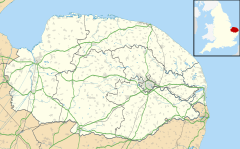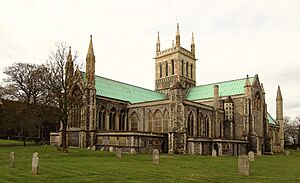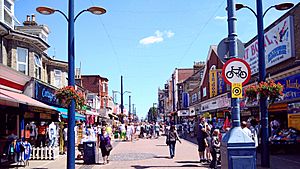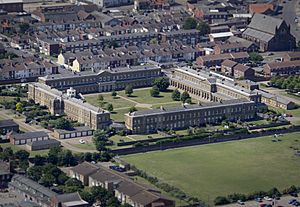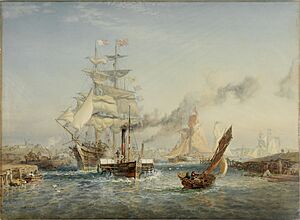Great Yarmouth facts for kids
Quick facts for kids Great Yarmouth |
|
|---|---|
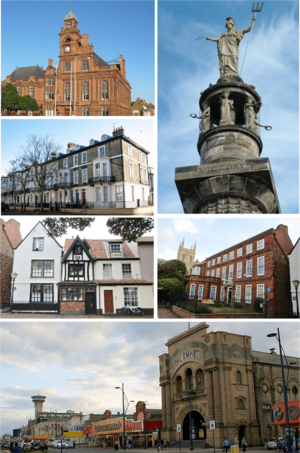 Clockwise from top left: Great Yarmouth Town Hall, Britannia Monument, Old Vicarage with the tower of the minster church in background, Church Plain, Empire Theatre and Marine Parade, Anna Sewell’s House, Camperdown |
|
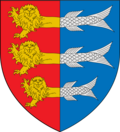 motto: Rex et Nostra Jura (Latin) "The King and Our Rights" |
|
| Area | 3.89 sq mi (10.1 km2) |
| Population | 99,745 (Borough, 2021) 28,985 (Built-up area, 2021) |
| OS grid reference | TG5207 |
| District |
|
| Shire county | |
| Region | |
| Country | England |
| Sovereign state | United Kingdom |
| Post town | GREAT YARMOUTH |
| Postcode district | NR30 |
| Dialling code | 01493 |
| Police | Norfolk |
| Fire | Norfolk |
| Ambulance | East of England |
| EU Parliament | East of England |
| UK Parliament |
|
| Website | [1] |
Great Yarmouth (often called Yarmouth) is a fun seaside town in Norfolk, England. It sits right on the River Yare, about 20 miles (32 km) east of Norwich. For a long time, it was famous for its fishing, especially for herring. While fishing isn't as big now, the town has become important for supporting North Sea oil and gas rigs. More recently, it's also a hub for offshore wind power and other green energy jobs.
Great Yarmouth has been a popular holiday spot since 1760. It's also a gateway from the beautiful Norfolk Broads to the North Sea. When the railway arrived in 1844, it became even easier and cheaper for people to visit. This led to the building of Wellington Pier in 1854 and Britannia Pier in 1858. Throughout the 20th century, Yarmouth grew into a busy resort with a promenade, shops, theatres, the Pleasure Beach, the Sea Life Centre, the Hippodrome Circus, and the Time and Tide Museum.
Contents
- Great Yarmouth's Location and People
- Great Yarmouth's Long History
- Fun Things to See and Do
- How Great Yarmouth is Governed
- Amazing Wildlife
- Sports and Fun Activities
- Local Media
- Getting Around Great Yarmouth
- First Responders
- Enterprise Zone
- Famous People from Great Yarmouth
- Twin Town
- Climate
- Images for kids
- See also
Great Yarmouth's Location and People
Great Yarmouth is built on a narrow strip of land, about 3.1 miles (5 km) long, between the North Sea and the River Yare. You'll find old houses in narrow streets, and a lively tourist area along the seafront. The town is connected to nearby places like Gorleston by bridges.
The main town area covers about 8.3 square miles (21.5 km²) and had about 47,288 people in 2002. The wider Great Yarmouth area, which includes places like Caister-on-Sea, has a population of around 68,317. The whole borough of Great Yarmouth had about 97,277 people in 2011. Most people living here are White British, with a smaller number of people from other European countries.
Great Yarmouth's Long History
Great Yarmouth has a very old history, dating back to Roman times. It grew from a fishing settlement near the mouth of the River Yare. Even before the Norman Conquest (1066), it was a busy place with many residents.
In 1101, the important Church of St Nicholas was built. This shows how important and wealthy the town was as a trading center. In 1208, King John gave Great Yarmouth a special charter. This charter gave the townspeople certain rights and freedoms, helping the town to grow even more. A fun tradition from this time was that the town had to send the King "one hundred herrings, baked in twenty four pasties" every year!
A hospital was founded in the town during the reign of Edward I. Later, in 1551, a grammar school was started, using the old hospital building.
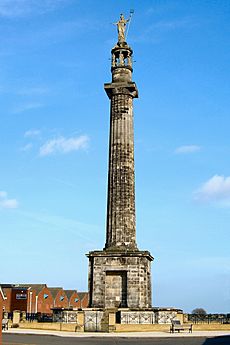

In 1668, the town's boundaries were expanded to include Little Yarmouth (also called Southtown). In 1703, the town got a new charter from Queen Anne, which changed its leadership to a mayor instead of two bailiffs.
In the early 1700s, the writer Daniel Defoe described Yarmouth as a very rich and important port for herring fishing. He said it had "the finest key in England, if not Europe," with ships lined up so closely you could walk from one to another. He also mentioned the beautiful buildings, like the custom-house and town-hall.
During the French Revolutionary Wars in 1797 and the Napoleonic Wars in 1807, Great Yarmouth was a key supply base for the British Navy. Ships would gather here before sailing to important battles like the Battle of Camperdown and the Battle of Copenhagen. The Royal Naval Hospital, a large building designed by William Pilkington, was built here in 1806 to care for sailors.
A sad event happened on 2 May 1845, when the Yarmouth suspension bridge collapsed. Many children had gathered to watch a clown, and the bridge couldn't hold their weight. Sadly, 79 people died.
Great Yarmouth had an electric tramway system from 1902 to 1933. Before World War I, it was a popular destination for large group trips, with thousands of workers from Bass's brewery visiting each year.
During World War I, Great Yarmouth was the first place in the UK to be bombed from the air by a German Zeppelin in 1915. It was also bombed by the German Navy in 1916.
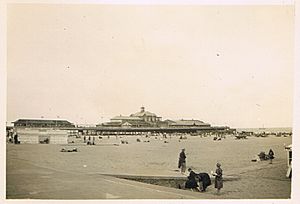
The town suffered from bombing raids by the German Luftwaffe during World War II. Even so, much of the old town remains, including two-thirds of its original 2,000-metre (1.2 mi) medieval wall and eleven of its eighteen towers. You can still see 17th-century Merchant's Houses and buildings from the Tudor, Georgian, and Victorian periods. Behind South Quay, there's a maze of narrow alleys called "The Rows," many of which survived the war.
The town was also badly hit by the North Sea flood of 1953. More recently, there have been problems with flooding, especially in 2006, when heavy rain caused flash floods that damaged many homes.
In February 2023, there was an explosion on the River Yare when an unexploded bomb from World War II accidentally went off during disposal.
Fun Things to See and Do
The Tollhouse, which dates back to the late 13th century, is one of Britain's oldest former prisons and civic buildings. You can still see large parts of the medieval town walls around the churchyard.
Great Yarmouth Minster (the Minster Church of St Nicholas) is one of the largest parish churches in England. Nearby, you can find the 17th-century timber-framed house where Anna Sewell (1820–1878), who wrote the famous book Black Beauty, was born.
The market place is one of England's largest and has been used since the 13th century. It's a great spot for shopping and trying the famous Yarmouth chip stalls!
Great Yarmouth railway station is where the trains from Norwich stop. In the past, the town had many more stations and direct links to London.
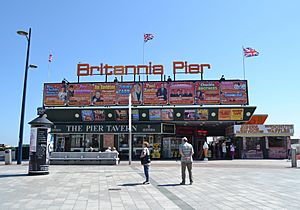
Yarmouth has two piers: Britannia Pier and Wellington Pier. Britannia Pier has the Britannia Theatre, which hosts many famous acts during the summer. It's one of the few old-fashioned "end-of-the-pier" theatres left in England.
You can see the giant wind turbines of the Scroby Sands Wind Farm from the seafront. You might even spot grey seals during their breeding season! The country's only full-time circus, Hippodrome Circus, is also near the seafront.
The Winter Gardens building, made of glass and cast iron, was brought here from Torquay in 1903! It's been a ballroom, roller skating rink, and even a nightclub. It's currently closed, but it's a very important historical building.
Great Yarmouth's seafront, known as "The Golden Mile," attracts millions of visitors every year. It has sandy beaches, indoor and outdoor attractions, and lots of amusement arcades. Besides the piers, you can visit Joyland, Pirates Cove Adventure Golf, the Sea Life Centre, Merrivale Model Village, and the Pleasure Beach.
In August 2019, the beautiful Venetian Waterways and gardens reopened. These canals and gardens were built in the 1920s and now offer rowing boats, pedalos, and even gondolas. The flowerbeds have been replanted with 20,000 plants, and the old cafe has been restored.
The Britannia Monument, also known as Nelson's Monument, is a tall tribute to Nelson, a famous British naval hero. It was finished in 1819, before London's Nelson's Column. The monument shows Britannia holding an olive branch and a trident. Many people in town think the statue should face the sea, but it actually faces inland towards Nelson's birthplace.
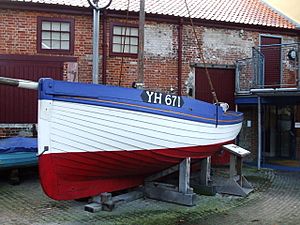
The famous writer Charles Dickens used Yarmouth as an important place in his novel David Copperfield, calling it "the finest place in the universe."
The Time and Tide Museum is a great place to learn about the town's history. It's built in an old herring smokery, reminding us of Yarmouth's past as a big fishing port. You can also see parts of the historic town wall nearby. Other museums include the National Trust's Elizabethan House, the Great Yarmouth Row Houses, and the privately owned Blitz and Pieces, which focuses on life during World War II.
In October 2021, the famous street artist Banksy created several murals in the town as part of his "A Great British Spraycation" project.
How Great Yarmouth is Governed
Great Yarmouth has two levels of local government: the Great Yarmouth Borough Council and the Norfolk County Council, which is based in Norwich. The borough council meets at the Great Yarmouth Town Hall.
Great Yarmouth has been an old borough for a very long time. In 1889, it became a county borough, meaning it was big enough to manage its own services, separate from Norfolk County Council. However, in 1974, this changed, and Great Yarmouth became part of a larger district, with Norfolk County Council providing county-level services again.
The town is also part of the Great Yarmouth area, which elects a Member of Parliament (MP) to the House of Commons in London. The current MP is Rupert Lowe from the Reform UK party, elected on 5 July 2024.
Amazing Wildlife
The Great Yarmouth area is home to many rare and interesting animals. The beach between the piers is a huge roosting spot for Mediterranean gulls. Breydon Water, just behind the town, is a major place for wading birds and waterfowl, with over 100,000 birds staying there in winter.
You can often see grey seals and common seals offshore, as well as seabirds like gannets, little auks, and guillemots. This area, including the nearby Halvergate Marshes, is protected to help these animals thrive. The North Denes beach area is a special scientific site because of its unique plants. It's also home to many skylarks, meadow pipits, and one of the largest little tern colonies in the UK each summer. You might even spot grayling and common blue butterflies.
The local cemetery is a well-known temporary stop for migrating birds in spring and autumn. Birds like common redstarts and pied flycatchers are often seen there.
Sports and Fun Activities
The main local football club is Great Yarmouth Town, also known as the Bloaters. They play in the Eastern Counties Football League. There's a strong local rivalry with Gorleston.
Great Yarmouth also has a horse racecourse.
Speedway racing used to happen here before and after World War II at the greyhound stadium. The post-war team was called the "Yarmouth Bloaters." Today, you can still watch banger and stock car racing there.
The main Marina leisure centre, built in 1981, has a big swimming pool and hosts live entertainment. In 2008, the world's first Segway Grand Prix opened at the Pleasure Beach gardens.
The English Pool Association (EPA) holds its national pool competitions at the Vauxhall Holiday Park in Great Yarmouth.
Local Media
Local news and TV shows for Great Yarmouth are provided by BBC East and ITV Anglia.
The town has several local radio stations: BBC Radio Norfolk, Heart East, Greatest Hits Radio Norfolk & North Suffolk, and Harbour Radio, a community station.
The Great Yarmouth Mercury is the town's weekly local newspaper, and the Eastern Daily Press covers news for the whole county.
Getting Around Great Yarmouth
Trains
The Wherry Lines connect Norwich and Great Yarmouth railway station, with trains running every hour.
In the past, Great Yarmouth had more railway lines coming into the town from different directions. However, many of these lines were closed down over the years. Today, Great Yarmouth station is the only one left in the borough.
Buses
The bus station in Great Yarmouth is located under the Market Gates Shopping Centre. Buses are mainly run by First Eastern Counties. The Excel X1 route connects Norwich and Lowestoft and stops in Great Yarmouth. Other local bus services link the town to nearby areas like Martham, Hemsby, Gorleston, and Bradwell.
Port and River
The River Yare separates Great Yarmouth from areas like Gorleston and Southtown, so the town's bridges are very important for transport. For a long time, Haven Bridge was the only way to cross the river. In the late 1980s, Breydon Bridge was built. In January 2020, construction began on a third river crossing, the Herring Bridge, which opened in February 2024. All three bridges can be lifted to let boats pass, which sometimes causes traffic jams!
A ferry used to run between Great Yarmouth and Gorleston, but it closed in the early 1990s.
Since 2006, a restored pleasure steamer called the Southern Belle offers regular river trips from Haven Bridge.
Construction work on the Great Yarmouth Outer Harbour, a deep-water port on the North Sea, started in 2007. It was hoped to have ferry links and a container terminal, but these plans didn't work out.
Lifeboat Station
Great Yarmouth has had a lifeboat station since at least 1802. Today, the RNLI (Royal National Lifeboat Institution) operates a lifeboat station at Riverside Road, Gorleston, with two lifeboats ready to help people at sea.
Roadstead
The area off Yarmouth where ships can anchor, called Yarmouth Roads, was very important in the early 1800s. Fleets of ships would gather here during the Napoleonic wars. Today, it's still used as an anchorage.
Roads
The town is served by the A47 and the A143. Until 2017, the A12 from London also ended in Yarmouth. Traffic can get very busy at rush hour around the town's roundabouts and bridges.
Third River Crossing
Plans for a third bridge across the river in Great Yarmouth were made to help ease traffic in the town centre. This new bridge, called the "Herring Bridge," started being built in January 2021 and opened in February 2024. During its construction, an unexploded German bomb from World War II was found and safely detonated.
Air
The North Denes Heliport, in the north of town, is used by CHC Helicopter. Although there were plans to close it in 2011, it is still operating.
First Responders
Great Yarmouth has a volunteer First Responder group from the East of England Ambulance Service. These volunteers are trained to respond to 999 emergency calls in their local community.
Enterprise Zone
The Great Yarmouth and Lowestoft Enterprise Zone was started in April 2012. This zone helps new businesses grow and create jobs in areas like Beacon Park and South Denes in Great Yarmouth.
Famous People from Great Yarmouth
Many interesting people have connections to Great Yarmouth:
- Anna Sewell (1820–1878), the author of Black Beauty, was born here.
- John Constable (1776-1837), a famous painter, painted Yarmouth Jetty.
- Captain George William Manby (1765–1854), an inventor who created marine life-saving equipment and the fire extinguisher.
- Sir James Paget (1814–1899), a famous Victorian surgeon, has a hospital named after him.
- Jack Cardiff (1914–2009), an Oscar-winning cinematographer.
- Sir Kenneth MacMillan (1929–1992), a famous choreographer for the Royal Ballet.
- Keith Chapman (born 1959), who created popular children's TV shows like Bob the Builder and PAW Patrol.
- Jason Statham (born 1967), the actor, lived in Great Yarmouth as a child.
- Matthew Macfadyen (born 1974), the actor, was born in Great Yarmouth.
- Myleene Klass (born 1978), a British musician and TV presenter.
Twin Town
Great Yarmouth is twinned with Rambouillet, France. This partnership started in 1956.
Climate
| Climate data for Hemsby, (1991–2020 normals, extremes 1978–2001) | |||||||||||||
|---|---|---|---|---|---|---|---|---|---|---|---|---|---|
| Month | Jan | Feb | Mar | Apr | May | Jun | Jul | Aug | Sep | Oct | Nov | Dec | Year |
| Record high °C (°F) | 14.0 (57.2) |
16.7 (62.1) |
21.1 (70.0) |
23.8 (74.8) |
26.2 (79.2) |
31.5 (88.7) |
31.9 (89.4) |
31.2 (88.2) |
26.8 (80.2) |
24.8 (76.6) |
17.9 (64.2) |
15.5 (59.9) |
31.9 (89.4) |
| Mean daily maximum °C (°F) | 7.4 (45.3) |
7.8 (46.0) |
9.9 (49.8) |
12.7 (54.9) |
15.6 (60.1) |
18.6 (65.5) |
20.8 (69.4) |
21.1 (70.0) |
18.6 (65.5) |
14.8 (58.6) |
10.7 (51.3) |
8.0 (46.4) |
13.9 (57.0) |
| Daily mean °C (°F) | 4.9 (40.8) |
5.0 (41.0) |
6.7 (44.1) |
9.1 (48.4) |
12.0 (53.6) |
14.8 (58.6) |
17.0 (62.6) |
17.2 (63.0) |
15.1 (59.2) |
11.7 (53.1) |
7.9 (46.2) |
5.5 (41.9) |
10.6 (51.0) |
| Mean daily minimum °C (°F) | 2.3 (36.1) |
2.2 (36.0) |
3.4 (38.1) |
5.5 (41.9) |
8.4 (47.1) |
10.9 (51.6) |
13.1 (55.6) |
13.2 (55.8) |
11.6 (52.9) |
8.6 (47.5) |
5.0 (41.0) |
2.9 (37.2) |
7.3 (45.1) |
| Record low °C (°F) | −14.1 (6.6) |
−9.1 (15.6) |
−4.3 (24.3) |
−1.9 (28.6) |
−1.5 (29.3) |
2.5 (36.5) |
5.6 (42.1) |
5.6 (42.1) |
1.3 (34.3) |
−3.0 (26.6) |
−4.7 (23.5) |
−7.9 (17.8) |
−14.1 (6.6) |
| Average precipitation mm (inches) | 50.5 (1.99) |
43.9 (1.73) |
42.6 (1.68) |
32.0 (1.26) |
43.3 (1.70) |
53.7 (2.11) |
61.6 (2.43) |
68.8 (2.71) |
52.7 (2.07) |
65.4 (2.57) |
70.0 (2.76) |
62.6 (2.46) |
647.3 (25.48) |
| Average precipitation days (≥ 1.0 mm) | 11.0 | 9.9 | 8.9 | 8.3 | 7.7 | 8.9 | 8.9 | 9.2 | 8.7 | 10.9 | 12.3 | 12.0 | 116.6 |
| Mean monthly sunshine hours | 65.7 | 84.5 | 127.2 | 189.7 | 226.2 | 225.3 | 228.7 | 211.9 | 153.0 | 114.4 | 76.9 | 59.7 | 1,763.1 |
| Source 1: Met Office | |||||||||||||
| Source 2: Starlings Roost Weather | |||||||||||||
Images for kids
-
The 41-metre (135 ft) tall Britannia Monument, built in 1817
-
Yarmouth Jetty by John Constable, 1822
-
Wellington Pier in 1930
-
Britannia Pier, May 2012
-
Small boat at the Time and Tide Museum
See also
 In Spanish: Great Yarmouth para niños
In Spanish: Great Yarmouth para niños


